|
Family: Columbidae (pigeons and doves)
Life
> Eukaryotes >
Opisthokonta
> Metazoa (animals) >
Bilateria >
Deuterostomia > Chordata >
Craniata > Vertebrata (vertebrates) > Gnathostomata (jawed
vertebrates) > Teleostomi (teleost fish) > Osteichthyes (bony fish) > Class:
Sarcopterygii (lobe-finned
fish) > Stegocephalia (terrestrial
vertebrates) > Tetrapoda
(four-legged vertebrates) > Reptiliomorpha > Amniota >
Reptilia (reptiles) >
Romeriida > Diapsida > Archosauromorpha > Archosauria >
Dinosauria
(dinosaurs) > Saurischia > Theropoda (bipedal predatory dinosaurs) >
Coelurosauria > Maniraptora > Aves
(birds) > Order: Columbiformes
Genera indigenous to southern Africa
|
Columba
(pigeons)
Three
native species and one naturalised species (Feral Pigeon Columba livia)
|
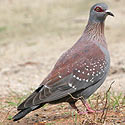 |
|
Treron (green
pigeons)
One species of Green pigeon occurs in southern
Africa: the African green pigeon Treron
calvus.
The African green-pigeon is found from Senegal to east
Africa, extending south to southern Africa, where it is fairly common in a
wide variety of habitats. It mainly eats fruit, as well as very small
quantities of seeds, flesh and even dry blood! The female builds the nest,
using material gathered by the male. The nest is a flat platform of twigs
and leaves, placed in the fork of a tree. It lays 1-2 eggs, which are
incubated by both sexes, for 13-14 days, with the chicks staying in the nest
for 11-13 days.
|
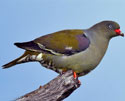 |
|
Aplopelia (Cinnamon
Dove)
One species: Cinnamon
dove Aplopelia larvata.
The Lemon dove is fairly common in near-coastal South
Africa, where it normally lives in leaf litter of indigenous forests. It
feeds mainly on fallen seeds and fruit, as well as small quantities of
invertebrates. Both sexes build the nest, which is a flat platform of twigs
and rootlets, usually placed 2.5 metres above ground in a tree or creeper.
It lays 1-3 eggs, which are incubated solely by the female, for 14-18
days. The chicks stay in the nest for 20 days, after which they remain with
their parents for 2 months, before becoming independent.
|
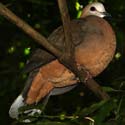 |
|
Streptopelia (turtle
doves)
|
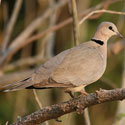 |
|
Turtur
3 Species indigenous to southern Africa: Blue-spotted wood-dove Turtur afer;
Emerald-spotted wood-dove Turtur
chalcospilos; and Tambourine
Dove Turtur tympanistria.
|
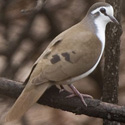 |
|
Oena capensis (Namaqua Dove)
The Namaqua dove occurs across sub-Saharan Africa, occupying a wide variety
of mostly arid habitats, such as Acacia savanna, arid shrubland,
farmland and rural gardens. It eats almost exclusively seeds, doing most of
its foraging on the ground, especially on gravel or on the edges of roads.
The nest is a fragile saucer made mostly of twigs, usually placed about 1
metre above ground in a shrub, tree sapling or dead dead branch. It lays 1-2
eggs, which are incubated by both sexes, for 13-16 days. In one study, the
chicks were brooded for the first 4-5 days of their lives, and remained in
the nest for 16 days. |
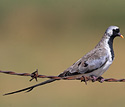 |
|
